Improving adherence to medication in adults with diabetes in the United Arab Emirates
Background:
Diabetes is a chronic medical condition and adherence to medication in diabetes is important. Improving medication adherence in adults with diabetes would help prevent the chronic complications associated with diabetes. A case control trial was used to study the effects of an educational session on medication adherence among adults with diabetes as measured by the Morisky Medication adherence scale (MMAS-8©).
Methods:
The study took place at the Dubai Police Health Centre between February 2015 and November 2015. Questionnaires were used to collect socio-demographic, clinical and disease related variables and the primary measure of outcome was adherence levels as measured by the Morisky Medication Adherence Scale (MMAS-8©). The intervention group involved a standardized thirty minute educational session focusing on the importance of adherence to medication. The change in MMAS-8© was measured at 6 months.
Results:
Four hundred and forty six patients were enrolled. Mean age 61 year +/− 11. 48.4 % were male. The mean time since diagnosis of diabetes was 3.2 years (Range 1–15 years). At baseline two hundred and eighty eight (64.6 %) patients were considered non-adherent (MMAS-8© adherence score < 6) while 118 (26.5 %) and 40 (9.0 %) had low adherence (MMAS-8© adherence score < 6) and medium adherence (MMAS-8© adherence scores of 6 to 7) to their medication respectively. The percentage of patients scoring low adherence MMAS-8 scores in the interventional group dropped from 64.60 % at baseline to 44.80 % at 6-months (p = 0.01). There was no obvious change in the adherence scores at baseline and at 6-months in the control group. Based on the study data, the Wilcoxon signed-rank test showed that at 6 months, the educational 30-min session on diabetes and adherence to medication did elicit a statistically significant change in adherence levels in adults with diabetes enrolled in the intervention arm (Z = −6.187, p <0.001).
Conclusion:
Adults with diabetes would benefit from educational sessions focusing on the importance of adherence to medication. Public health strategies should focus on wider educational strategies targeting medication adherence in diabetic patients in the UAE.
Keywords:
Diabetes, Adherence, Medication
Authors:
Mohammed M. M. Al-Haj Mohd 1,2*; Hai Phung 1; Jing Sun 1; Donald E. Morisky 3
Authors place of work:
School of Public Health, Griffith University, Gold Coast, Australia.
1; Dubai Police Health Centre, Dubai, United Arab Emirates.
2; Department of Community Health Sciences, UCLA Fielding School of Public Health, Los Angeles, U. S. A.
3
Published in the journal:
BMC Public Health 2016, 16:857
Category:
Research article
doi:
https://doi.org/10.1186/s12889-016-3492-0
© 2016 The Author(s).
Open access
This article is distributed under the terms of the Creative Commons Attribution 4.0 International License (http://creativecommons.org/licenses/by/4.0/), which permits unrestricted use, distribution, and reproduction in any medium, provided you give appropriate credit to the original author(s) and the source, provide a link to the Creative Commons license, and indicate if changes were made. The Creative Commons Public Domain Dedication waiver (http://creativecommons.org/publicdomain/zero/1.0/) applies to the data made available in this article, unless otherwise stated.
The electronic version of this article is the complete one and can be found online at: http://bmcpublichealth.biomedcentral.com/articles/10.1186/s12889-016-3492-0
Summary
Background:
Diabetes is a chronic medical condition and adherence to medication in diabetes is important. Improving medication adherence in adults with diabetes would help prevent the chronic complications associated with diabetes. A case control trial was used to study the effects of an educational session on medication adherence among adults with diabetes as measured by the Morisky Medication adherence scale (MMAS-8©).
Methods:
The study took place at the Dubai Police Health Centre between February 2015 and November 2015. Questionnaires were used to collect socio-demographic, clinical and disease related variables and the primary measure of outcome was adherence levels as measured by the Morisky Medication Adherence Scale (MMAS-8©). The intervention group involved a standardized thirty minute educational session focusing on the importance of adherence to medication. The change in MMAS-8© was measured at 6 months.
Results:
Four hundred and forty six patients were enrolled. Mean age 61 year +/− 11. 48.4 % were male. The mean time since diagnosis of diabetes was 3.2 years (Range 1–15 years). At baseline two hundred and eighty eight (64.6 %) patients were considered non-adherent (MMAS-8© adherence score < 6) while 118 (26.5 %) and 40 (9.0 %) had low adherence (MMAS-8© adherence score < 6) and medium adherence (MMAS-8© adherence scores of 6 to 7) to their medication respectively. The percentage of patients scoring low adherence MMAS-8 scores in the interventional group dropped from 64.60 % at baseline to 44.80 % at 6-months (p = 0.01). There was no obvious change in the adherence scores at baseline and at 6-months in the control group. Based on the study data, the Wilcoxon signed-rank test showed that at 6 months, the educational 30-min session on diabetes and adherence to medication did elicit a statistically significant change in adherence levels in adults with diabetes enrolled in the intervention arm (Z = −6.187, p <0.001).
Conclusion:
Adults with diabetes would benefit from educational sessions focusing on the importance of adherence to medication. Public health strategies should focus on wider educational strategies targeting medication adherence in diabetic patients in the UAE.
Keywords:
Diabetes, Adherence, Medication
Background
Diabetes mellitus is a chronic metabolic disease affecting approximately 341 million to 371 million people worldwide [1, 2]. Furthermore, it is estimated that one third of those affected (approximately 122.5 million) are not aware that they have the condition [3].
The oil boom has led to a massive increase in the GDP and disposable income of the people of the United Arab Emirates (UAE). The UAE was ranked as the 19th highest income countries of the world in 2012 (International Monetary Fund) and is categorized as a high income country according to the (World bank, 2012). This has led to a more affluent lifestyle, and from health point an increase in total calorie intake per person together with a decrease in calorie expenditure. This has led to a nationwide obesity pandemic with the rates of obesity climbing to record highs and standing at about 68 % of the population according to one estimate from 2007 .
The UAEis now listed as the country with the 11th highest prevalence of diabetes globally (primarily type-2) [4]. Furthermore, metabolic control of diabetes is reportedly poor, leading to an increased risk of associated complications [5]. Almost 70 % of Emirati nationals are reported to be overweight or obese [6], and one third of Emirati children are also now obese [7]; these figures are two to three times those of international standards [8], thus, it is unsurprising that the prevalence of type-2 diabetes has escalated.
Medication non-adherence is of increasing concern for healthcare providers despite the known benefits of modern treatment regimens, with prevalence reported in one study to be in excess of 50 % of diabetic patients. The consequences of non-adherence include not only health-related consequences (i.e. failure of treatment, rehospitalisation, death), but also financial consequences as the cost of emergency medical interventions as a consequence of non-adherence outweigh the combined cost of an adhered-to medication regimen [9]. The WHO has identified non-adherence as a multifactorial problem caused by the interplay of factors from any of the following 5 areas: 1) the patient, 2) the condition, 3) the type of therapy prescribed, 4) socioeconomic factors, and 5) health system related factors [10]. Several studies have been carried out looking at medication adherence in diabetic patients around the world; however no studies have been performed in the U.A.E [11, 12, 13].
Methods
Study design
A case control trial was used to study the effects of an educational session on medication adherence among adults with diabetes as measured by the Morisky Medication adherence scale (MMAS-8©). Patients were randomized to standard care (control group) or standard care plus an educational session (intervention group) on the importance of adherence to medication. The MMAS-8 © scores were collected via questionnaires at baseline and at the end of the study. The change in MMAS-8 © scores was analysed using statistical software. The research topic was granted an ethical clearance through the Human Research Ethics Committee at Griffith University GU Ref No: PBH/11/14/HREC and confirmed with the Dubai Police Research Ethics standards.
Study setting
The study took place at the Dubai Police Health Services Clinic between February 2015 and November 2015. This centre provides primary care and speciality care for all Dubai Police employees and members of their families and had over 200,000 clinic visits in 2014 alone.
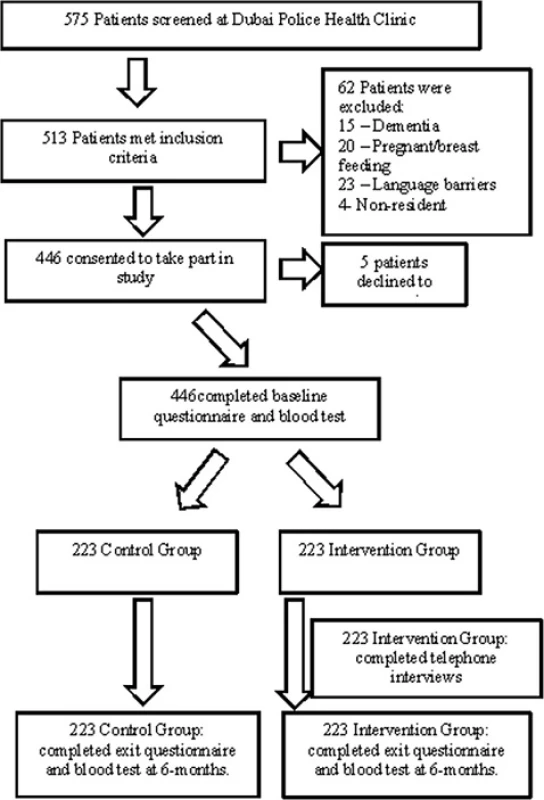
Inclusion criteria
All patients were type 2 adults with diabetes on at least one anti-diabetic medication following a diabetes diagnosis of 1 year or more. Male and female patients between the age of 18 and 80 years were eligible for the study. The following exclusions applied: cognitive impairment, pregnant or breast feeding women, non-residents and patients who did not comprehend either the English or Arabic language.
The investigators identified and screened potential participants in the following manner: all patients present in the waiting area of the diabetic clinic were asked if they were willing to talk to the investigator. If the person agreed, then an informed consent was read and explained by the investigators. Once verbal consent was obtained, the inclusion and exclusion criteria were checked.
Data was collected primarily via questionnaires. Patients were asked to fill in these questionnaires in order to gather demographic information and information regarding motivations and associated behaviours. These questionnaires were written using the Android Database software package (MEMENTO). The questionnaires were then handed out in electronic form using an Android tablet. The tablets were purchased for the purpose of this research and were solely used for this purpose. These tablets were secured with an encrypted password and were locked in drawer at the research office when not in use. The tablets and questionnaires were supervised by one of the research investigators at the time of interview to ensure the correct handling of the questionnaire and to troubleshoot any problems if they would arise. The questionnaire forms were based on a number of field styles including free text, date, single best answer and multi-check selections. The database software collated the results into an excel sheet which was later exported to a computer for further data analysis. All participants completed the questionnaires in a private clinic room.
A simple random number generator was used to randomly allocate patients to either the control group or the intervention group. The intervention group then went on to attend a 30-min education session about diabetes and its associated medication (this group is referred to as the ‘intervention group’), whilst the other group was not invited to attend this session, and instead received the same level of education regarding diabetes as is offered as standard from UAE healthcare providers (this group is referred to as the ‘control group’). Following which, the intervention group received a weekly phone call to check on their progress for the duration of 3 months, the control group were not eligible for these phone calls. The follow-up phone call served more of a motivational strategy by asking the patients standardized questions like: 1- Do you have any concerns about your diabetes medication? – Interviewer to try and answer the patients concerns and refers to clinician as appropriate. 2- Did you face circumstances that have prevented you from picking up your medication from your pharmacy? Interviewer: To try and address these concerns and refer to social worker as appropriate.
The patients were then re-invited to undertake the questionnaires at 6 months from the time of their initial visit in order to determine any long-term improvements in medication adherence. Furthermore, whole blood samples were collected by venepuncture from all patients at their initial and 6-month visits in order to determine HbA1c concentrations.
Educational session on adherence to medication
Patients randomized to the intervention arm were subjected to a 30 min educational session focusing on the importance of medication adherence. The educational session was undertaken by a diabetes nurse and consisted of a 30 min session aided with a PowerPoint presentation based on slides adopted from the International Diabetes Federation (IDF) education modules published online in 2011. The PowerPoint presentation was structured around medication adherence and compliance. The importance of medication adherence as well as barriers to self-management were covered and explained by covering the following themes:
Check that the patient understands when and how they should take their medicine.
Ask the patient when they will take the medicine.
Explain the benefits of the medicine—stress the fact that patients may not have any symptoms of diabetes or feel at all ill; therefore unlikely that the medicine will make them “feel better”.
Be sure it is understood that the medicine is having a beneficial effect inside the body.
Ensure that people know what to expect in terms of side effects, and that these might only be short term; thus people will be more likely to continue with the medicine (another reason people stop is that they did not like the side effects).
The aim of the interview was to educate the patients on the importance of medication and the importance of adherence in the long term on the outcomes of their diabetes. Breifly, the investigators would have explained the action of each diabetes medication, the time at which the medication was to be taken and the benefits of taking these medications. These points would have re—inforced the patients’ knowledge on diabetes management and medication compliance.
The didactive nature of the slide show presentation was coupled with a more collaborative approach where the diabetes educator would encourage the patient to ask questions about medication adherence and answer those questions.
Data variables
The data collated via the questionnaires included the following variables: age, gender, ethnicity, marital status, highest level of education attained, working conditions, transport availability, smoking status, diabetes duration, cultural factors (dress wear, behaviors in Ramadan, perception towards obesity), number of anti-diabetic medication, insulin therapy, the Depression, Anxiety and Stress scale (DASS-21) and International Physical Activity Questionnaire (IPAQ) score. The Morisky Medication Adherence Scale −8 (MMAS-8) score was used to measure the outcome of adherence to medication. MMAS-8. The Glycated Haemoglobin test (HbA1c (%)) was used to check the validity of the MMAS-8 score in this cohort as a measure of adherence to medication among the study participants. IBM SPSS-20 was used for statistical analyses.
Morisky medication adherence scale
The Morisky Medication Adherence Scale (MMAS) was designed to determine adherence behaviours [14]. For this study the 8-item model of this scale was used; patients were asked 8 questions (Table 1) designed to determine which factors affect how well they adhered to their medication regimen. Patients are required to answer the questions with either a ‘yes’ or a ‘no’, with the final question taking the form of a typical five-point Likert item. Positive answers (i.e. yes) are scored a 1 and negative answers (i.e. no) are scored a 0. From these responses a final score was calculated with three possible outcomes; a score of >2 corresponded to low medication adherence, a score of 1 or 2 corresponded to medium medical adherence, and a score of 0 corresponded to high medical adherence. The MMAS is a popular, easy and economical method of data collection, facilitating the collection of a large amount of data in a short period of time [15].
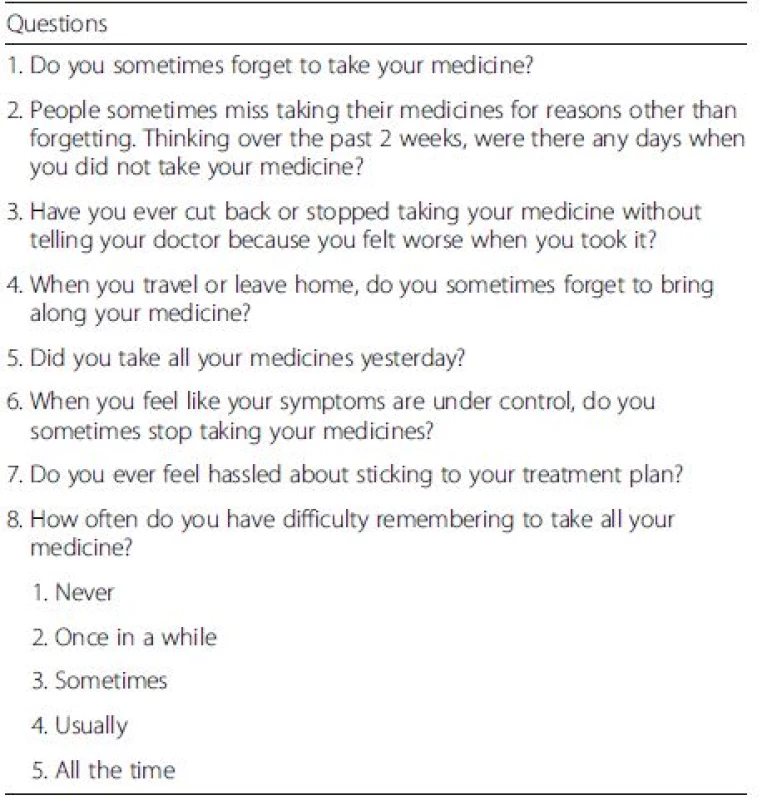
Results
A total of 513 patients were identified as meeting the study inclusion criteria, and 442 patients agreed to take part of the study. There were no patients lost to follow-up (Fig. 1). There were 223 patients in the control group and 223 patients in the control group. The baseline characteristics were well distributed between the two groups with no significant differences among the two groups. 48.4 % (n = 216) of patients were male. The mean time since diagnosis of diabetes was 3.2 years (Range 1–15 years). Emaratis represented 56.1 % of the study population patients, followed by Arab Non Emarati patients (38.1 %) and Asian patients (5.8 %) (Tables 2 and 3).
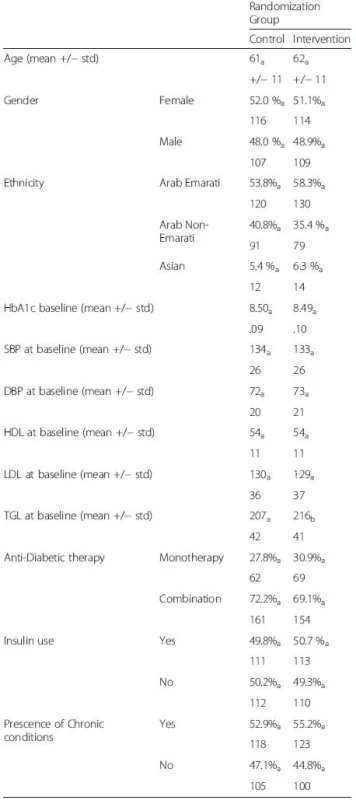
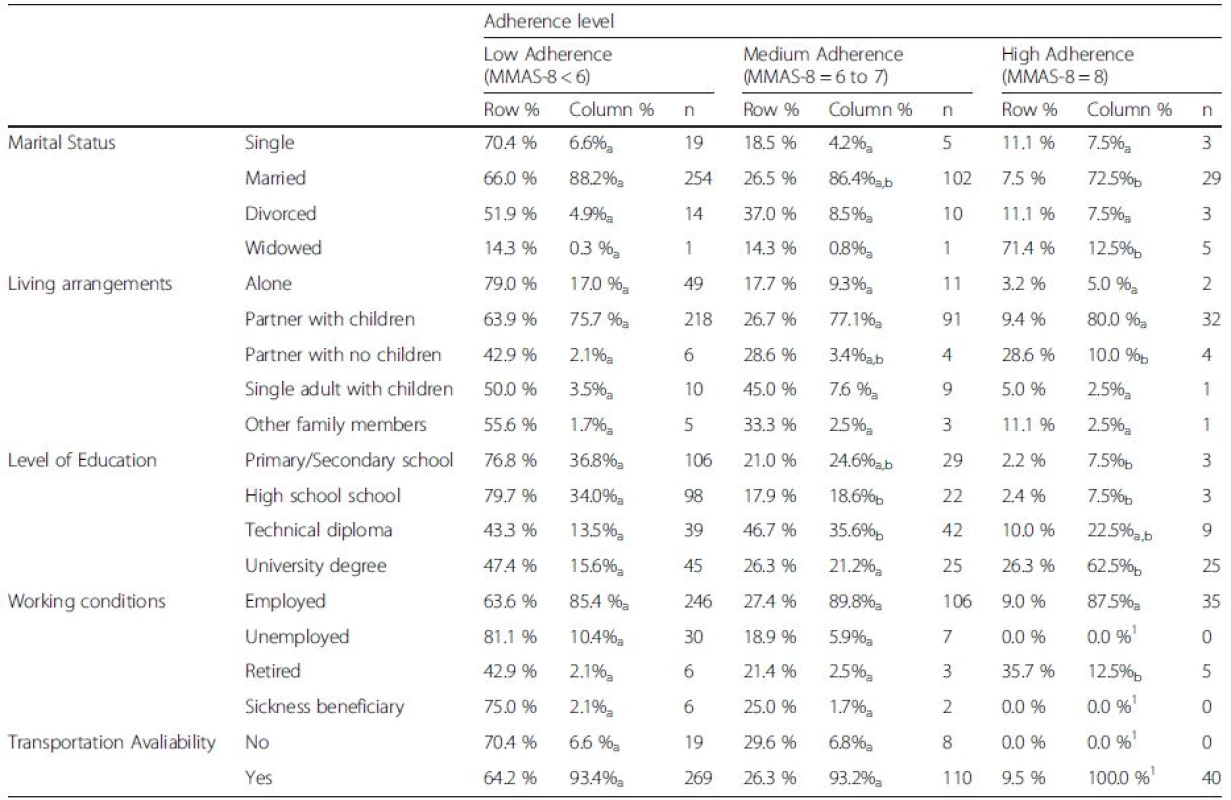
Two hundred and eighty eight (64.6 %) patients were considered non-adherent (MMAS-8© adherence score <6) while 118 (26.5 %) and 40 (9.0 %) had medium adherence (MMAS-8© adherence score 6 to 7) and high adherence (MMAS-8© adherence scores of <8) to their medication respectively (Fig. 2).
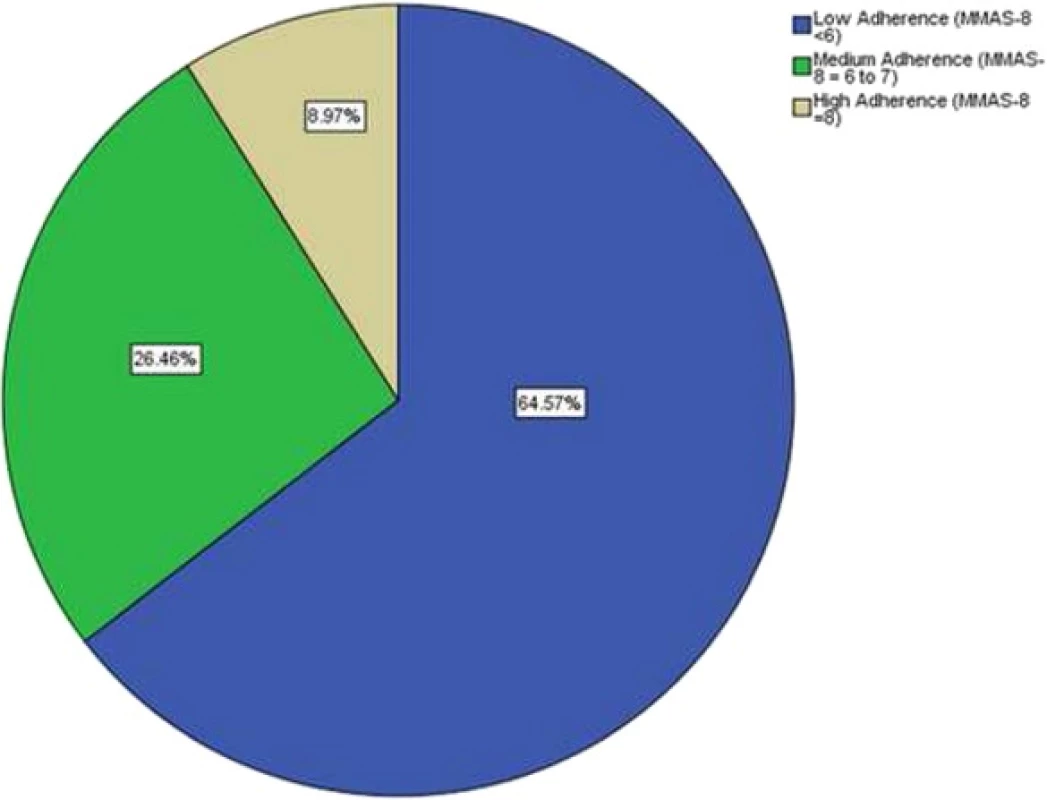
The strongest predictor for adherence as predicted by the multi-logistic regression model was the patient’s level of education. A technical diploma certificate as compared to a primary school level of education was the strongest predictor of adherence (OR = 66.1 CI: 6.93 to 630.43); p < 0.001). The patient’s age was also a predictor of adherence with older patients reporting higher levels of adherence (OR = 1.113 (CI: 1.045 to 1.185; p = 0.001 for every year increase in age). The duration of diabetes was also a predictor of adherence (OR = 1.830 (CI: 1.270 to 2.636; p = 0.001 for every year increase in the duration of diabetes). Other predictors to medication adherence include Insulin use, ethnicity and certain cultural behaviours (Fig. 3).
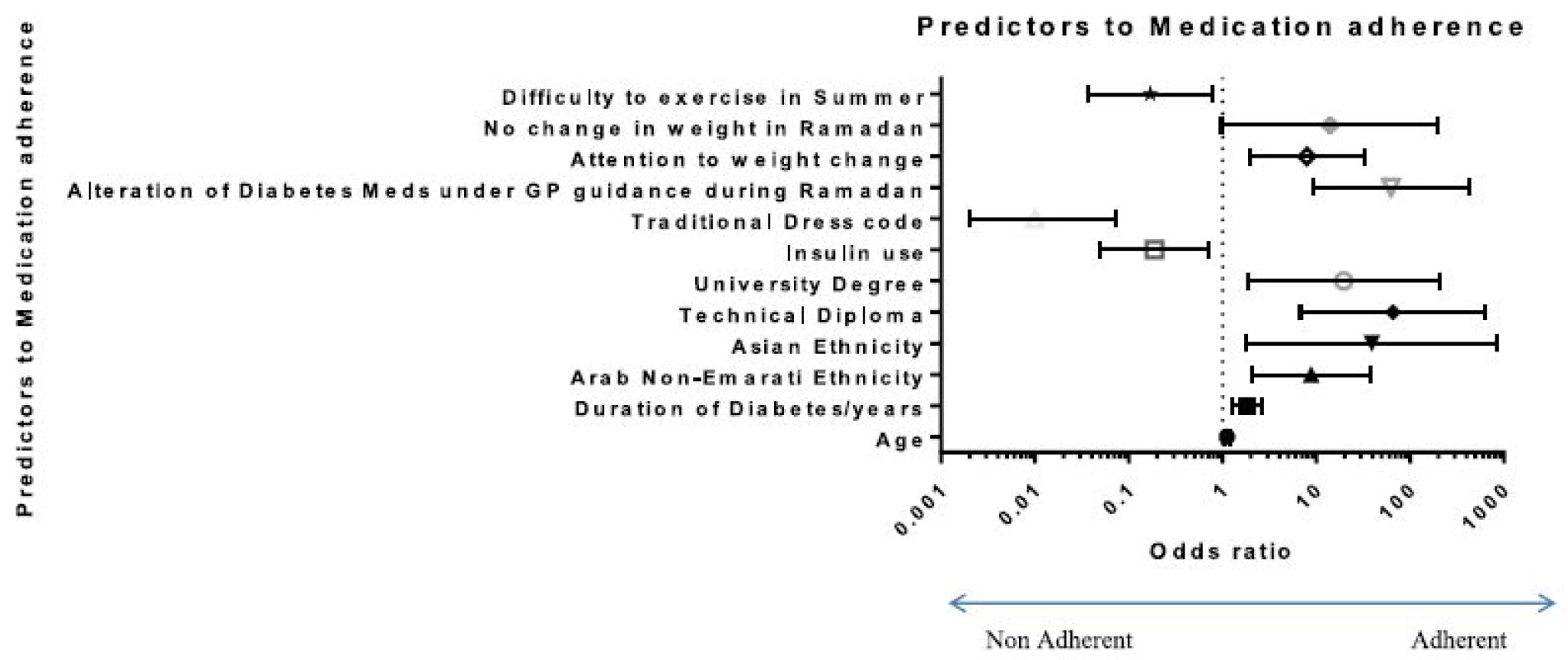
Reliability, internal consistency and validity of MMAS-8
The Cronbach’s alpha test was calculated for the 8-item MMAS-8 and this was reliable at 0.736 Omission of any of the 8-items of the MMAS-8 questionnaire resulted in a lower Cronbach’s alpha. The validity of MMAS-8 adherence score was assessed by testing the ability of the score to distinguish between groups of individuals that differ from each other according to the HbA1c. There was a significant difference in the Mean HbA1c levels among the three adherence groups. Mean HbA1c was 9.24, 7.33 and 6.60 % in the low, medium and high adherence groups respectively (p < 0.05).
Adherence as measured by the MMAS-8 ordinal scores
Descriptive statistics of the data analysed showed a significant increase in the adherence levels in the interventional arm. The percentage of patients scoring low adherence MMAS-8 scores in the interventional group dropped from 64.60 % at baseline to 44.80 % at 6-months (p = 0.01). Meanwhile there was no obvious change in the adherence scores at baseline and at 6-months in the control group (Fig. 4).
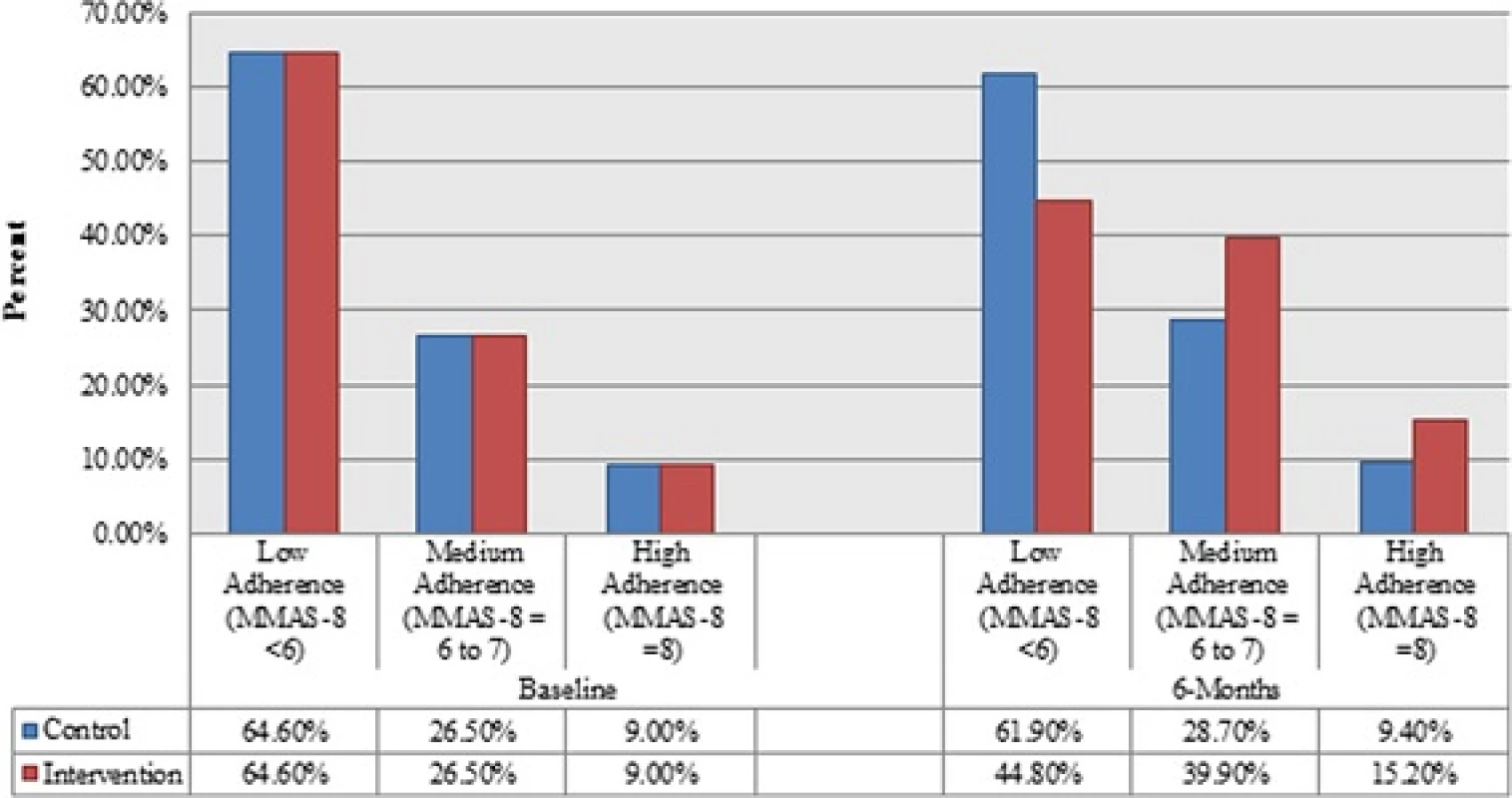
Interventional arm
Based on the study data, the Wilcoxon signed-rank test showed that at 6 months, the educational 30-min session on diabetes and adherence to medication did elicit a statistically significant change in adherence levels in patients enrolled in the intervention arm (Z = −6.187, p <0.001). The median MMAS-8 Score rating was 1.0 (Low adherence) pre-intervention and 2.0 (medium adherence) post-intervention.
Control arm
On the other hand, the Wilcoxon signed-rank test showed that at 6 months, there was no statistically significant change in adherence levels in patients in the control group (Z = −1.528, p =0.127). The median MMAS-8 Score rating was 1.0 (Low adherence) at baseline and at 6 months.
Changes in HbA1c
The mean HbA1c at 6 months was compared to the baseline mean HbA1c in both the Intervention and Control groups using the paired samples T-test. The T-test showed a significant decrease in mean HbA1c at 6-months in the intervention group from baseline (8.5 vs 7.2 % p < 0.001). At the same time there was a non-significant decrease in HbA1cn the control group (8.50 vs 8.45 % p = 0.079) Table 4.

Discussion
Limited data exist on the adherence of diabetics in the United Arab Emirates to their medication prescribed by their doctors as well as on the factors influencing their adherence. This single centre case control study of 442 patients in the United Arab Emirates primarily looked at the utility of an educational session at increasing the levels of medication adherence among patients with diabetes. The results showed an increase in the MMAS-8 adherence scores with the percentage of non-adherents dropping from 65 to 45 %.
Studies in other countries have demonstrated poor adherence rates of medication among diabetics and patients suffering with other chronic conditions. Al Mazroui demonstrated a significant reduction in the levels of HbA1c among diabetics receiving an intensive educational program over a 12 month period of time (baseline vs. 12 months; 95 % confidence interval) of HbA1c8.5 % (8.3, 8.7) vs. 6.9 % (6.7, 7.1) [16]. Reed demonstrated the important role of chronic diabetes clinics in the UAE at improving diabetes outcomes as measured by HbA1c levels and blood pressure. However, neither of the former ‘UAE based’ studies had been designed to study the levels of adherence to medication among diabetics [17].
Despite this lack of data from the United Arab Emirates and the Arab world as a whole, there have been numerous studies from around the world looking at the impact of medication adherence on outcome in patients of chronic medical diseases including diabetes. An American observational study concluded that high adherence levels to medication among diabetics were associated with an overall reduction in healthcare costs [18]. Another retrospective study of over 11,000 patients showed that poorly non-adherent diabetics had higher all-cause hospitalization and all-cause mortality compared to adherent diabetics [9]. Adherence to medication in diabetes is therefore of upmost importance, and identifying factors that lead to poorer medication compliance should be identified to guide healthcare policy.
Non-adherence may arise as a consequence of the patient knowingly disregarding their treatment regimen (active non-adherence), or as a consequence of carelessness or forgetfulness, whereby patients occasionally omit their medication from their daily routine or take that medication later than required (passive non-adherence).
The WHO has identified non-adherence as a multifactorial problem caused by the interplay of factors from any of the following 5 areas: 1) the patient, 2) the condition, 3) the type of therapy prescribed, 4) socioeconomic factors, and 5) health system related factors (WHO, 2001). This complex interaction of different factors leading to non-adherence has been studied by many groups around the world. In Italy, Viana et al. published a meta-analysis of RCTs in patients with type-1 diabetes which focused on psychological, telecare and educational interventions to improve treatment compliance. This meta-analsysis has shown that psychological approaches to improve adherence to diabetes care treatment modestly reduced HbA1c in patients with type 1 diabetes; telecare and education interventions however did not change glycemic control [19].
Koenisberg et al. have shown that reviewing patient goals and treatment regimens at regular intervals (e.g. monthly, biannually, or annually) has been shown to help patients to persist in adhering to their treatment plan [20]. Encouraging patients to monitor their own progress is also important in order for long-term adherence to be successful; it is important, however, for patients to develop their own record system to ensure they maximise their chances of adhering to a long-term treatment plan. Flexibility in treatment options is also important as patients are more likely to achieve their goals using treatments they feel more comfortable with.
Education has been identified as a major barrier to adherence to clinical interventions. Patient counselling to improve patient knowledge of the disease and the benefits of both medical intervention and lifestyle changes has been introduced. Coaching is also now available to encourage positive lifestyle choices, empower patients, develop self-sufficiency and assist patients in identifying and overcoming their own barriers to adherence .
In our cohort of patients the strongest independent predictor of adherence was the patient’s education level. A technical diploma certificate as compared to a primary school level of education was the strongest predictor of adherence (OR = 66.1 CI: 6.93 to 630.43); p < 0.001). Educational websites have been set up in order to raise health literacy and allow an anonymous forum in which patients can clarify any issues which may be preventing medication adherence. However many patients lack access to such resources. Furthermore, tailoring specific exercise plans and personalising diet plans may also help patients achieve their lifestyle-change goals. This study of type 2 diabetes patients in the United Arab Emirates explored the utility of an educational session on improving medication adherence. The adherence rates among adults with diabetes in this group of patients followed through a primary care setting were extremly low (64.6 % of patients were considered non-adherent with a MMAS-8© adherence score < 6).
The data analysed showed an obvious increase in the adherence levels in the interventional arm. The percentage of patients scoring low adherence MMAS-8 scores in the interventional group dropped from 64.60 % at baseline to 44.80 % at 6-months (Pearson Chi-square p = 0.01). Meanwhile there was no obvious change in the adherence scores at baseline and at 6-months in the control group.
Based on the study data, the Wilcoxon signed-rank test showed that at 6 months, the educational 30-min session on diabetes and adherence to medication did elicit a statistically significant change in adherence levels in diabetics enrolled in the intervention arm (Z = −6.187, p <0.001). The median MMAS-8 Score rating was 1.0 (Low adherence) pre-intervention and 2.0 (medium adherence) post-intervention.
The patients in this study were individually subjected to the educational session which was both time-consuming and man-power intensive. This could be facilitated in the future by asking patients to attend group sessions that could also touch upon other aspects of diabetes besides medication compliance. The Desmond trial showed that a structured group education programme for patients with newly diagnosed type 2 diabetes resulted in greater improvements in weight loss and smoking cessation and positive improvements in beliefs about illness but there were no differences in HA1c levels up to 12 months after diagnosis [21]. Trento et al. has also shown in an RCT over a 5-year period that group care and education of patients with diabetes was associated with better quality of life and knowledge of diabetes compared to control individual care [22].
The intial interview consisted of only 30 min of “one-on-one” time between the interviewer and the patient. This time is shorter when compared to the time utilitized in group intervention programmes. For example, Weinger et al. has shown that a structured behavioral intervention consisting of five 2-hour sessions, delivered over 6 weeks, of highly structured behavior-based activities and information was effective in improving glycemia in adults with long-duration diabetes. The limitations of this study include the small size, which despite meeting the pre-determined study size sample predicted before starting the study would continue to be a source of population bias error. The MMAS is a popular, easy and economical method of data collection, facilitating the collection of a large amount of data in a short period of time. Furthermore, the questions are purposely phrased to avoid the ‘yes-saying’ bias as it is known that patients feel they should provide healthcare providers with a positive response. However, there are limitations to this method of data collection; the MMAS does not account for personal or lifestyle factors (e.g. age, physical ability, means of transport, known methods of communication, etc.), and the outcome of these questions can be biased by patients supplying false information. There was no direct measurement of adherence to medication however the MMAS-8 score has been well validated in measuring medication adherence in diabetes and other chronic conditions.
Conclusion
Adherence to medication among diabetics in the U.A.E. continues to be low. In this study there was a significant improvement in the adherence to medication in diabetics taking part in an educational session focusing on the importance of anti-diabetes medication and adherence to it. The results of such a pilot program would be of upmost value in supporting the implantation of bigger trials or even a national educational program in the UAE which up to today is still lacking. Public health policy makers in the U.A.E. should be equipped and ready with all the knowledge to get services ramped up quickly as the ‘Diabetes Tsunami’ hits its shores.
Abbreviations
DASS, Depression, anxiety and stress scale; HbA1c, Glycated haemoglobin alpha concentration; IPAQ, International physical activity questionnaire; MMAS-8, Morisky medication adherence scale- 8; U.A.E., United Arab Emirates; WHO, World health organization
Funding
No funding was obtained for this study.
Availability of data and materials
All data is available in electronic format by contacting the corresponding author (MA) at asm08560@gmail.com.
Authors’ contributions
All authors contributed in the design and statistical analysis of the study. MA, HP, JS and DM contributed to the concept and design of the study, MA coordinated the data collection at the study site. MA, DM was involved in the statistics and analysis. All authors read and approved the final manuscript.
Competing interests
The authors declare that they have no competing interests.
Consent for publication
Not Applicable.
Ethical approval and consent to participate
The research topic was granted an ethical clearance through the Human Research Ethics Committee at Griffith University GU and through Human Research Ethics Committee at Dubai Police Health Clinics (DPHC) Ref No: PBH/11/14/HREC. All procedures performed were in accordance with the ethical standards of the institutional and/or national research committee and with the 1964 Helsinki declaration and its later amendments or comparable ethical standards. This article does not contain any studies with animals performed by any of the authors. Informed consent was obtained from all individual participants included in the study.
The authors have no disclosures to make.
Received: 13 May 2016
Accepted: 12 August 2016
Published: 24 August 2016
* Correspondence:
Mohammed M. M. Al-Haj Mohd
1School of Public Health,
Griffith University,
Gold Coast, Australia
2Dubai Police Health Centre,
Dubai, United Arab Emirates
asm08560@gmail.com
Zdroje
1. Danaei G, et al. National, regional, and global trends in fasting plasma glucose and diabetes prevalence since 1980: systematic analysis of health examination surveys and epidemiological studies with 370 country-years and 2.7 million participants. Lancet. 2011;378(9785):31–40.
2. International diabetes federation. Facts and figures [online] available at: http://www.idf.org/worlddiabetesday/toolkit/gp/facts-figures Accessed 12 Nov 2013.
3. Saudek CD, et al. A new look at screening and diagnosing diabetes mellitus. J Clin Endocrinol Metab. 2008;93(7):2447–53.
4. Diabetes UAE. 2011. Diabetes facts [online] available at: http://diabetesuae.ae/diabetes/diabetes-facts Accessed 12 Nov 2013
5. Saadi H, et al. Prevalence of diabetes mellitus and its complications in a population-based sample in Al Ain, United Arab Emirates. Diabetes Res Clin Pract. 2007;78(3):369–77.
6. NG SW, Zaghloul S, Ali HI, Harrison G, Popkin BM. The prevalence and trends of overweight, obesity and nutrition-related non-communicable disease in the Arabian Gulf States. Obes Rev. 2011;12(1):1–13.
7. Malik M, Bakir A. Prevalence of overweight and obesity among children in the United Arab Emirates. Obes Rev. 2007;8(1):15–20.
8. AL-Haddad FH, Little BB, Abdul Ghafoor AG. Childhood obesity in United Arab Emirates schoolchildren: a national study. Ann Hum Biol. 2005;32(1):72–9.
9. Ho PM, Bryson CL, Romfield JS. Medication adherence; its importance in cardiovascular outcome. Circulation. 2009;119:3028–35.
10. World Health Organisation. Global status report on non-communicable disease 2010. Geneva: World Health Organisation; 2011.
11. Jamous RM, Sweileh WM, Abu-Taha AS, Sawalha AF, Zyoud SH, Morisky DE. Adherence and satisfaction with oral hypoglycemic medications: a pilot study in Palestine. Int J Clin Pharm. 2011;33(6):942–8.
12. Sweileh WM, Ihbesheh MS, Jarar IS, Taha AS, Sawalha AF, Zyoud SH, Jamous RM, Morisky DE. Self-reported medication adherence and treatmentsatisfaction in patients with epilepsy. Epilepsy Behav. 2011;21(3):301–5.
13. Sweileh WM, et al. Influence of patients’ disease knowledge and beliefs about medicines on medication adherence:findings from a cross-sectional survey among patients with type 2 diabetes mellitus in Palestine. BMC Public Health. 2014;14:94.
14 Morisky DE, Green LW, Levine DM. Concurrent and predictive validity of a self-reported measure of medication adherence. Med Care. 1986;24:67–74.
15 Morisky DE, Ang A, Krousel-Wood M, Ward HJ. Predictive validity of a medication adherence measure in an outpatient setting. J Clin Hypertens. 2008;10(5):348–54.
16 Al Mazroui NR, Kamal MM, Ghabash NM, Yacout TA, Kole PL, McElnay JC. Influence of pharmaceutical care on health outcomes in patients with Type diabetes mellitus. Br J Clin Pharmacol. 2009;67:547–57. doi:10.1111/j.1365-2125.2009.03391.x.
17 Reed R, et al. A controlled before–after trial of structured diabetes care in primary health centres in a newly developed country. International J Qual Health Care. 2005;17(4):281–6. doi:10.1093/intqhc/mzi043.
18 Sokol MC, McGuigan KA, Verbrugge RR, Epstein RS. Impact of medication adherence on hospitalization risk and healthcare cost. Med Care. 2005;43(6):521–30.
19 Viana LV, Gomes MB, Zajdenverg L, Pavin EJ, Azevedo MJ, On Behalf of the Brazilian Type 1 Diabetes Study Group (BrazDiab1SG). Interventions to improve patients’ compliance with therapies aimed at lowering glycated hemoglobin (HbA1c) in type 1 diabetes: systematic review and meta-analyses of randomized controlled clinical trials of psychological, telecare, and educational interventions. Trials. 2016;17:94. http://doi.org/10.1186/s13063-016-1207-6.
20 Koenisberg MR, Bartlett D, Cramer JS. Facilitating treatment adherence with lifestyle changes in diabetes. Am Fam Physician. 2004;69(2):309–16.
21 Weinger K, Beverly EA, Lee Y, Sitnokov L, Ganda OP, Caballero AE. The impact of a structured behavioral intervention on poorly controlled diabetes: a randomized controlled trial. Arch Intern Med. 2011;171(22):1990–9.
22 Trento M, et al. A 5-year randomized controlled study of learning, problem solving ability, and quality of life modifications in people with type 2 diabetes managed by group care. Diabetes Care. 2004;27(3):670–5. doi:10.2337/diacare.27.3.670.
Článek vyšel v časopise
BMC Public Health
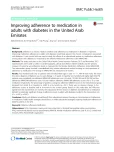
2016 Číslo 857
- Jak všímavé bytí pomáhá zdravotníkům předcházet syndromu vyhoření
- „Jednohubky“ z klinického výzkumu – 2025/16
- Tirzepatid – nová éra v léčbě nadváhy a obezity
- Přerušovaný půst může mít významná zdravotní rizika
- Britský výzkum s českou stopou odhalil desítky asociací nemocí se vzácnými variantami genů
Nejčtenější v tomto čísle
